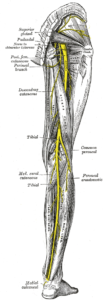
Sciatic Nerve
by Diana Perez PT, M.Sc., Yoga Therapist
Sciatica is a common condition that occurs when the sciatic nerve (or nerve roots that comprise the sciatic nerve) become pinched, compressed, irritated, or inflamed. That seems straightforward, but in my experience with patients many people misunderstand the term sciatica in various ways. So before discussing how yoga can help with this condition—a topic I’ll address in Part 2 of this series—I’m going to discusses what sciatica is and what causes it.
The first misunderstanding many people have is that they think they have sciatica simply because they are experiencing low back pain or have pain anywhere into the leg. But, in fact, the pain and/or abnormal sensation(s) need to be into a particular area or areas of the buttock and leg to qualify as sciatica. And having sciatica might or might not involve back pain.
To help you understand exactly what sciatica is, here’s a little bit about the sciatic nerves. There are two sciatic nerves: right and left. Each sciatic nerve is made up of nerve roots that exit from the spine of the lower back (lumbar and sacral) and join together into a thick sciatic nerve that runs down into each leg. The sciatic nerve is the longest nerve in the body and the thickest (approximately 1 inch/2 cm in diameter). It runs through the pelvis into the buttocks, through the gluteal muscles, down the back of the thigh (in the hamstring muscles), and eventually into the lower legs (calves and shins) and the feet. So true sciatica pain would be felt in any of these areas. Typically, it is felt only into one leg, but it is possible to have bilateral sciatica with pain into both legs.
In addition to an aching pain, sciatica can also cause the following symptoms into the above-mentioned areas of the leg and foot: numbness; tingling or “pins and needles”; a sense of tightness in the muscles; burning sensations; muscle weakness; sharp or shooting pains; loss of reflexes. The pain and other symptoms can be along the whole trajectory of the nerve or only in certain parts of the trajectory. For example, one person might feel pain in the whole length of the leg, another person might feel pain only in the buttock and/or hamstring area only, and another person might have pain/sensory/motor changes in the calf and bottom of the foot only. The presentation varies from person to person.
CAUTION: Symptoms that can be caused by severe nerve root or sciatic nerve compression and that require immediate medical consultation include: Loss of bladder or bowel control, pain or numbness in the pelvic floor/testicular area, loss of control of the foot (it drops when you try to walk), or significant loss of strength in the leg.
The second misunderstanding many people have is that sciatica is the cause of their pain or other abnormal sensations. But sciatica is not itself a diagnosis. Instead, it is a symptom, and the cause for it needs to be determined. There are many causes for sciatica, some of which are from the lumbar spine and some not.
The following are causes of sciatica that do stem from the lumbar spine. These conditions can result in compression and sometimes inflammation of the nerve roots as they exit the spine:
- Bulging or herniated discs in the lumbar area. This happens when one of the spinal disks bulges or herniates through its protective outer ring.
- Degenerative lumbar disc disease. This happens when the jelly-like cushioning between the vertebrae (spinal bones) wears down.
- Lumbar central or foraminal stenosis. This happens when the spinal canal or the exit holes for the spinal nerves in the lower back narrow.
- Bone spurs in the spine. This happens when hard boney protrusions/bumps have grown on the vertebrae of the spine and stick out into the space where the nerve roots exit.
- Spondylolysis or spondylolisthesis. This happens when one of the vertebrae in the spine slips out of place in relation to the vertebra beneath it.
The following are examples of other causes of sciatica:
- Inflammation of the sacroiliac joint due to arthritic conditions or dysfunction. Inflammation of the sacroiliac can be caused by arthritic conditions (such as osteoarthritis, rheumatoid arthritis, or ankylosing spondylitis) or a dysfunction of the joint caused by trauma and abnormal stressors, such as pregnancy. This inflammation can spread to the nerve roots forming the sciatic nerve because these nerves run just in front of and are adhered to the front of the sacroiliac joint.
- Piriformis syndrome. This happens when your piriformis muscle (a muscle in your buttocks) compresses the sciatic nerve as it passes through the buttocks. The nerve can either be compressed under the piriformis muscle or, in some cases, in the muscle itself because for some people the sciatic nerve branches in two in the buttock area (rather than behind the knee) and one of these branches pierces this muscle.
- Pelvic floor dysfunction. Pain and muscle tightness in the pelvic floor can create tension in the muscles and/or fascia of the buttocks, and thus indirectly impact the sciatic nerve.
- Direct trauma to the sciatic nerve. This happens due to a blow, prolonged compression, or a laceration to the nerve as it courses through the leg.
- Internal organ conditions or tumors, cysts, and abscesses in the spine or pelvic cavity. These problems are rare, but possible.
- Pregnancy. As the pregnancy progresses and the fetus grows in size, often the lumbar curve of the spine becomes exaggerated. The added weight in the abdominal area, the change in the centre of gravity of the body, and the changes to the lumbar curve can exert more pressure unto the low back and sacroiliac joints. This can cause the nerve roots forming the sciatic nerve or the sciatic nerve itself to become compressed or irritated.
Understanding the cause of your sciatica is critically important not only to determine the best treatments for it, but also to hopefully prevent future re-occurrences. If you think you have sciatica, you should get a professional diagnosis from a medical professional, particularly if the condition lasts more than 3 weeks and is getting progressively worse rather than better. Stay tuned for my post on how yoga can help people with sciatica.
 Diana Perez is a sports and rehabilitation Physical Therapist and a certified Professional Yoga Therapist (PYTI-2017) who has worked in the medical field, academia, and fitness industry for over 40 years. She completed a Masters Degree in Rehabilitation Science in 1997 (Faculty of Medicine; McGill University) and was a lecturer / professor at the School of Physical & Occupational Therapy; Faculty of Medicine (McGill University) from 1985-2004. She has advanced specializations in Sports Physiotherapy, Manual Therapy, Back & Neck Rehabilitation, Muscle Energy, and Myofascial Release, She also has formal training/certifications in the areas of wellness, functional nutrition, naturopathy, Ayurvedic medicine, acupuncture and yoga therapy, and has been integrating yoga into her clinical practices since 2004.
Diana Perez is a sports and rehabilitation Physical Therapist and a certified Professional Yoga Therapist (PYTI-2017) who has worked in the medical field, academia, and fitness industry for over 40 years. She completed a Masters Degree in Rehabilitation Science in 1997 (Faculty of Medicine; McGill University) and was a lecturer / professor at the School of Physical & Occupational Therapy; Faculty of Medicine (McGill University) from 1985-2004. She has advanced specializations in Sports Physiotherapy, Manual Therapy, Back & Neck Rehabilitation, Muscle Energy, and Myofascial Release, She also has formal training/certifications in the areas of wellness, functional nutrition, naturopathy, Ayurvedic medicine, acupuncture and yoga therapy, and has been integrating yoga into her clinical practices since 2004.
Diana Perez has been practicing yoga since 2002 and teaching yoga since 2004. Her yoga influences have been mainly from the schools of Hatha, Ashtanga, Moksha and Anusara and she completed 2 teacher training certifications (Hatha & Ashtanga; RYA-200 hours). Her specialties are in Yoga Therapy, Yoga Anatomy, Injury Prevention, Asana Alignment, and Yin Yoga. She is on the faculty of several Yoga Teacher Training Programs in Canada (Sun and Moon; Heaven & Earth; Happy Tree; Moksha WI Yin), and teaches yoga classes and many types of workshops to yoga teachers as well as to the general public. She is also on the faculty of the Atlas-Medic Medvox Program for who she develops and teaches courses to health care professional on how to integrate yoga into health care. She currently continues to practice as a physiotherapist and yoga therapist at the Medi-Club Physio Centre in the West Island of Montreal.
• Follow Yoga for Healthy Aging on Facebook and follow Nina on Instagram • Order Yoga for Times of Change here and purchase the companion videos here • Order Yoga for Healthy Aging: A Guide to Lifelong Well-Being here.


Leave A Comment